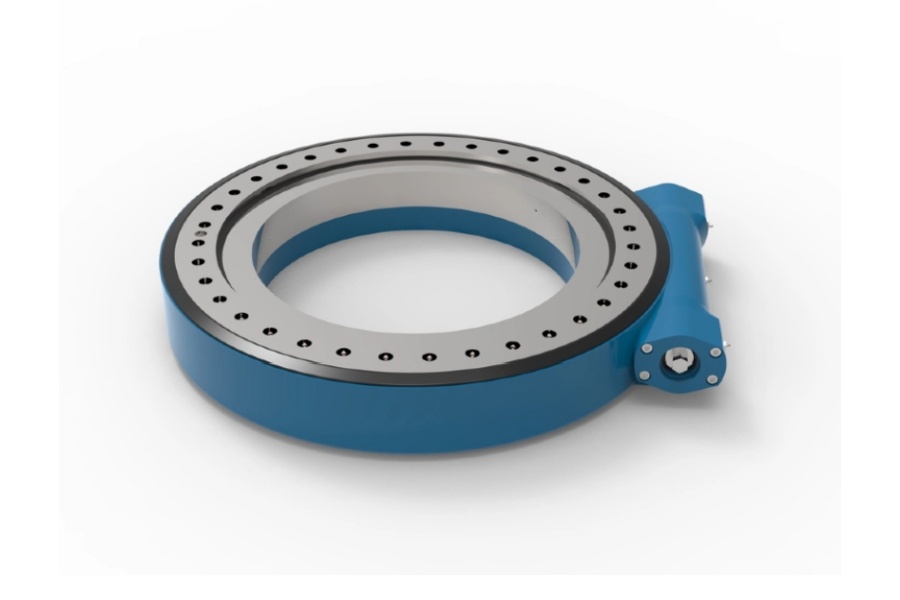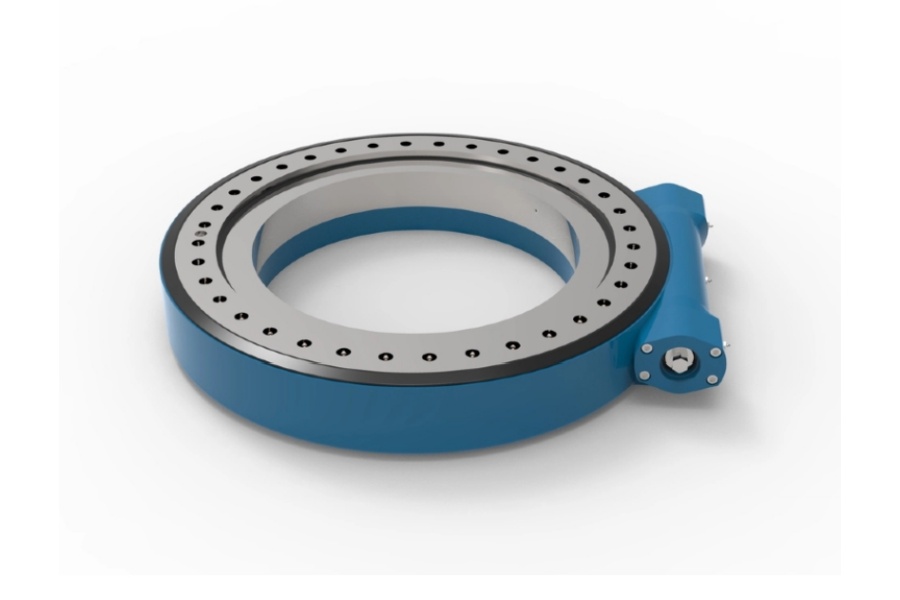
Применение поворотных приводов в медицинском оборудовании
Что такое поворотный привод?
Аповоротный приводЭто прецизионный механический привод, сочетающий в себе поворотный подшипник со встроенным редуктором и часто включающий монтажные фланцы и интерфейсы для подключения двигателя. Его основная функция — обеспечение контролируемого непрерывного вращательного движения вокруг одной оси с одновременной поддержкой значительных осевых, радиальных и моментных нагрузок. Основным компонентом является поворотный подшипник, имеющий внутреннее и внешнее кольца с зубьями, обработанными как внутри, так и снаружи. Эта шестерня входит в зацепление с червячной передачей, обычно приводимой в движение электродвигателем, создавая компактную и высокоэффективную приводную систему. Основной принцип работы основан на червячном механизме, обеспечивающем высокое передаточное отношение на одной ступени. Такая конструкция обеспечивает значительное механическое преимущество, позволяя относительно небольшому двигателю развивать огромный выходной крутящий момент. Кроме того, червячная передача часто обладает свойством самоторможения, предотвращая обратный ход и надежно удерживая груз без необходимости использования внешнего тормоза. Поворотные приводы разработаны для применений, требующих надежного, прочного и точного вращательного движения в условиях высоких нагрузок, что делает их незаменимыми в различных отраслях промышленности: от возобновляемой энергетики и тяжелого машиностроения до аэрокосмической и медицинской техники.

Применение поворотных приводов в медицинском оборудовании
Интеграция поворотных приводов в медицинское оборудование представляет собой одно из наиболее требовательных и критически важных применений этой технологии, где точность, надежность и бесперебойность работы имеют первостепенное значение. В медицинских системах визуализации поворотные приводы играют важнейшую роль в компьютерных томографах (КТ), обеспечивая точное вращательное движение, необходимое для сборки гантри. Гантри, содержащий рентгеновскую трубку и детекторы, должен плавно и непрерывно вращаться вокруг пациента с высокой скоростью, сохраняя при этом исключительную точность позиционирования. Поворотные приводы в этом случае должны работать с минимальной вибрацией и практически без люфта, чтобы гарантировать отсутствие ухудшения качества изображения из-за механических дефектов. Требования к надежности чрезвычайно высоки, поскольку любой сбой во время диагностических процедур может иметь серьезные последствия. Аналогично, в системах магнитно-резонансной томографии (МРТ) поворотные приводы используются в столах позиционирования пациентов, требующих точного, контролируемого перемещения в магнитную канавку и из нее. Эти столы должны перемещаться плавно, без рывков и резких движений, которые могут причинить дискомфорт пациентам или повлиять на результаты визуализации.
Оборудование для лучевой терапии представляет собой еще одно важнейшее медицинское применение поворотных приводов. В линейных ускорителях, используемых для лечения рака, поворотные приводы обеспечивают точное позиционирование, необходимое для доставки целевых доз облучения к опухолям, минимизируя при этом воздействие на здоровые ткани. Эти системы часто включают в себя несколько поворотных приводов для управления различными осями движения, что позволяет терапевтам позиционировать пациентов с субмиллиметровой точностью. Приводы должны сохранять свою позиционную целостность под нагрузкой и обеспечивать стабильную работу на протяжении тысяч циклов лечения. Системы роботизированной хирургии также включают в себя технологию поворотных приводов для позиционирования и манипуляции инструментами. Плавность и точность перемещения поворотных приводов делают их идеальными для хирургических применений, где движение без дрожания и абсолютная точность позиционирования необходимы для успешных результатов. В этих системах поворотные приводы могут использоваться для позиционирования роботизированных рук, эндоскопических камер или специализированных хирургических инструментов с точностью, необходимой для минимально инвазивных процедур.
Автоматизация медицинских лабораторий представляет собой растущую область применения поворотных приводов. В автоматизированном диагностическом оборудовании и системах обработки образцов поворотные приводы обеспечивают вращательное движение каруселей образцов, дозаторов реагентов и испытательных модулей. Эти области применения требуют стабильной, надежной работы и возможности работы в различных условиях окружающей среды, включая лаборатории с контролируемой температурой, а иногда и в стерильных условиях. Компактная конструкция современных поворотных приводов позволяет разработчикам медицинского оборудования создавать более рационализированные и компактные системы, сохраняя при этом эксплуатационные характеристики, необходимые для медицинского применения. Во всех медицинских применениях поворотные приводы должны соответствовать строгим требованиям к чистоте и коррозионной стойкости, что часто требует использования специальных материалов и покрытий, выдерживающих многократную очистку дезинфицирующими средствами и предотвращающих загрязнение в чувствительных медицинских условиях.
Характеристики поворотных приводов
Поворотные приводы характеризуются уникальным набором технических характеристик, делающих их особенно подходящими для сложных применений, включая медицинское оборудование. Их важнейшей особенностью является исключительная грузоподъемность при компактных размерах. Один блок может одновременно выдерживать значительные осевые нагрузки (параллельно оси вращения), радиальные нагрузки (перпендикулярно оси) и моментные нагрузки (наклонные силы), что исключает необходимость в использовании множества отдельных компонентов и упрощает общую конструкцию системы. Интегрированный червячный механизм обеспечивает высокое передаточное отношение на одной ступени, что обеспечивает впечатляющий выходной крутящий момент при относительно небольшом размере. Это позволяет разработчикам медицинского оборудования добиваться мощного вращательного движения, используя компактные двигатели, подходящие для медицинских устройств с ограниченным пространством.
Возможность самоблокировки, присущая многим конструкциям червячных передач, представляет собой ещё одну важную характеристику, особенно важную в медицинских приложениях, где безопасность превыше всего. Эта особенность предотвращает обратный ход, что означает, что привод сохраняет своё положение без внешних тормозных систем даже при значительных нагрузках. Это критически важно для систем позиционирования пациентов, где неконтролируемое движение может привести к травмам или поставить под угрозу выполнение медицинских процедур. Точность и управляемость поворотных приводов делают их идеальными для медицинских приложений, требующих точного позиционирования. Редуктор обеспечивает плавное, контролируемое движение с минимальной вибрацией, что крайне важно для систем визуализации и чувствительного лабораторного оборудования. Современные поворотные приводы обеспечивают точность позиционирования в пределах мельчайших угловых измерений, что соответствует требованиям медицинской диагностики и лечения.
Интегрированная конструкция поворотных приводов обеспечивает значительные преимущества для производителей медицинского оборудования. Объединяя множество функций в едином предварительно собранном и испытанном блоке, поворотные приводы снижают сложность проектирования, упрощают монтаж и повышают общую надежность системы. Эта интеграция также способствует повышению жесткости конструкции и крутильной жесткости, минимизируя прогиб под нагрузкой и обеспечивая стабильную производительность. Для медицинского применения поворотные приводы часто выпускаются со специальными характеристиками, включая коррозионно-стойкие материалы, медицинские смазочные материалы и герметичную конструкцию, предотвращающую загрязнение, — все это важные характеристики для оборудования, используемого в здравоохранении. Прочность и долговечность поворотных приводов, достигаемые благодаря использованию высококачественных материалов и точности изготовления, гарантируют, что они смогут выдерживать высокие требования непрерывного медицинского использования, сохраняя при этом высокие эксплуатационные характеристики в течение длительного срока службы.
Применение поворотных приводов
Помимо медицинского оборудования, поворотные приводы выполняют критически важные функции во многих отраслях, где требуется точное вращательное движение под нагрузкой. В возобновляемой энергетике они являются важнейшими компонентами систем слежения за солнцем, где они точно позиционируют фотоэлектрические панели в соответствии с траекторией движения солнца, увеличивая сбор энергии на 25–30% по сравнению со стационарными установками. Их самоблокировка предотвращает нежелательные перемещения при сильном ветре, обеспечивая стабильность системы. В ветроэнергетических системах поворотные приводы используются как в механизмах рыскания (которые удерживают ротор в положении, ориентированном по направлению ветра), так и в системах управления шагом (которые регулируют угол наклона лопастей для оптимальной производительности и защиты от штормов). Эти области применения требуют исключительной надежности и способности работать в суровых условиях окружающей среды.
Строительная промышленность и тяжелое машиностроение представляют собой еще одну важную область применения поворотных приводов. Экскаваторы используют их для поворота верхней части конструкции на 360 градусов, а мобильные краны полагаются на них для перемещения и позиционирования стрелы. Бетононасосы используют поворотные приводы для точного позиционирования подающих стрел, а подъемные платформы используют их для вращения и позиционирования корзины. В этих приложениях поворотные приводы должны выдерживать ударные нагрузки, воздействие загрязняющих веществ окружающей среды и непрерывную работу в тяжелых условиях. Промышленная автоматизация и робототехника представляют собой растущие области применения поворотных приводов. Они обеспечивают точное вращательное движение в автоматизированных сборочных системах, роботизированных сварочных аппаратах, оборудовании для обработки материалов и упаковочном оборудовании. Их компактная конструкция и высокий крутящий момент делают их идеальными для автоматизированных систем с ограниченным пространством, требующих надежного вращательного движения.
В аэрокосмической и оборонной промышленности поворотные приводы используются для позиционирования антенн, вращения систем наблюдения и наведения систем вооружения. Эти приложения требуют исключительной точности и надежности в сложных условиях и часто требуют использования специальных материалов и покрытий для защиты от коррозии и снижения веса. В морской промышленности они применяются в палубных кранах, лебёдочных системах и механизмах позиционирования радаров, где коррозионная стойкость и надёжность в условиях соленой воды имеют решающее значение. В индустрии развлечений применяются вращающиеся сцены, системы позиционирования камер и оборудование для создания спецэффектов, где плавное, контролируемое вращение расширяет производственные возможности. Во всех этих разнообразных приложениях поворотные приводы обеспечивают сочетание точности, надёжности и грузоподъёмности, что делает их незаменимыми компонентами современных механических систем.
Факторы, влияющие на цену поворотного привода
Стоимость поворотных приводов значительно варьируется в зависимости от множества технических и коммерческих факторов, влияющих на их конструкцию, сложность производства и эксплуатационные характеристики. Физические размеры и грузоподъёмность являются основополагающими факторами, определяющими стоимость. Более крупные приводы с большим диаметром подшипника и более высокой грузоподъёмностью требуют больше материала, более сложной механической обработки и сложных процессов термообработки, что приводит к существенному повышению стоимости. Точность и эксплуатационные характеристики существенно влияют на цену: для медицинских и аэрокосмических приводов требуются более жёсткие допуски, высококачественные материалы и более комплексные испытания, чем для промышленных аналогов. Приводы, рассчитанные на работу с практически нулевым люфтом, имеют более высокую цену благодаря требуемой точности изготовления.
Выбор материалов и требования к защите от коррозии существенно влияют на стоимость. Стандартные конструкции из углеродистой стали с базовыми защитными покрытиями представляют собой наиболее экономичный вариант, в то время как конструкции из нержавеющей стали с современными покрытиями, такими как Geomet®, или специальными покрытиями, разработанными для медицинского применения, могут удвоить или утроить базовую стоимость. Уровень адаптации и требуемые специальные функции являются ещё одним важным фактором стоимости. Стандартные каталожные изделия наиболее экономичны, в то время как индивидуальные конструкции со специальными конфигурациями крепления, встроенными энкодерами, уникальными решениями по герметизации или специальными смазочными материалами, разработанными для медицинского применения, требуют дополнительных инженерных и производственных затрат. Варианты интеграции двигателя влияют на цену: индивидуальные крепления двигателя, специализированные муфты или полные комплекты привода двигателя увеличивают общую стоимость.
Объем заказа и объем производства существенно влияют на себестоимость единицы продукции за счет экономии масштаба. Крупные партии OEM-заказов позволяют производителям амортизировать фиксированные затраты на множество единиц продукции, в то время как заказы с небольшим объемом влекут за собой более высокую себестоимость единицы продукции. Рыночные факторы, включая колебания цен на сырье, особенно на компоненты из специальных сталей и сплавов, влияют на базовую цену. Условия глобальной цепочки поставок и транспортные расходы также способствуют колебаниям цен. Требования к сертификации, особенно для медицинских изделий, для которых применяются требования сертификации по ISO 13485 и другие стандарты, предъявляемые к медицинским изделиям, существенно увеличивают затраты из-за необходимости строгого документирования, испытаний и контроля качества. Наконец, требования к технической поддержке, включая индивидуальные инженерные услуги, специализированные испытания и расширенные гарантии, могут вносить свой вклад в общую стоимость решений для поворотных приводов.
Поставщик поворотных приводов
ЛИРАДРАЙВКомпания LYRADRIVE зарекомендовала себя как ведущий производитель прецизионных поворотных приводов для медицинских и других высокопроизводительных приложений, сочетая инженерный опыт со строгими процессами контроля качества. Ассортимент продукции компании включает стандартные и индивидуальные решения, специально разработанные для применения в медицинском оборудовании, с такими характеристиками, как медицинские смазочные материалы, коррозионно-стойкие материалы и специализированные системы герметизации, которые отвечают уникальным требованиям медицинских сред. Инженерная команда LYRADRIVE тесно сотрудничает с производителями медицинского оборудования для разработки индивидуальных решений, которые легко интегрируются в системы диагностической визуализации, оборудование для позиционирования пациента и системы автоматизации лабораторий. Система менеджмента качества компании включает в себя соответствие нормам и стандартам для медицинских устройств, гарантируя, что их продукция соответствует строгим требованиям отрасли здравоохранения. Благодаря постоянным инвестициям в производственные технологии и процессы обеспечения качества, LYRADRIVE сохраняет свою позицию надежного поставщика для производителей медицинского оборудования по всему миру, предоставляя надежные, высокопроизводительные решения в области поворотных приводов, которые соответствуют строгим стандартам современных медицинских технологий.



